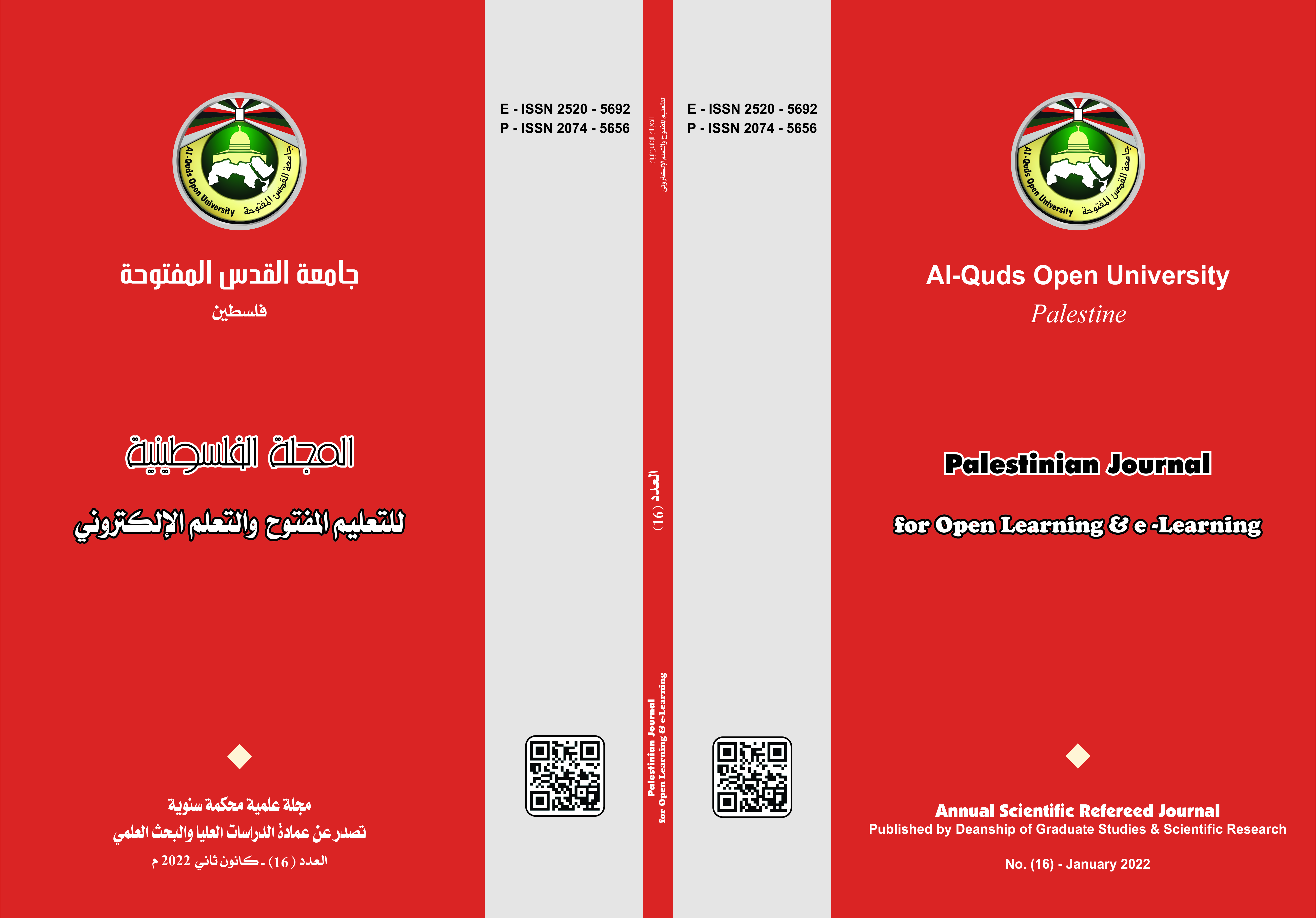تطبيق نموذج نضج تجربة التعليم الإلكتروني على جامعة القدس المفتوحة في فلسطين
DOI:
https://doi.org/10.33977/0280-010-016-010الكلمات المفتاحية:
تعليم إلكتروني، تعليم مدمج، إدارة التعليم الإلكتروني، نموذج نضج التعليم الإلكتروني.الملخص
جامعة القدس المفتوحة هي إحدى مؤسسات التعليم العالي الرائدة على مستوى العالم العربي في مجال التعليم المدمج والتعليم المفتوح. وقد أثبتت الجامعة دورها الريادي عير الأعوام الثلاثين الماضية في خدمة الشعب الفلسطيني وذلك من خلال تخريج ما يزيد عن المائة وثلاثين ألف طالب وطالبة من برامجها المختلفة. دأبت الجامعة على تبني نظام التعليم المدمج، وذلك من خلال إدخال نظام التعليم الإلكتروني كمركب أساس في العملية التعليمية. في هذه الورقة، قمنا بتطبيق نموذج قياس نضج التعليم الإلكتروني على الشق الإلكتروني من التعليم المدمج في الجامعة، حيث تم التعامل مع كافة عناصر النموذج المختلفة وتطبيقها على الجوانب ذات العلاقة في الجامعة. تتلخص هذه العناصر في إيصال الخدمات الإلكتروني، ومن ثم تخطيط الخدمات، ومن ثم إدارة الخدمات وصولاً إلى مرحلة ضبط الأداء. تم اتباع التوصيات الخاصة في نموذج القياس المعتمد، وذلك من خلال التعامل مع الاستبانات المرتبطة ببنود النموذج. تم توزيع الاستبانات بحسب دوائر الاختصاص في الجامعة مع إيضاح الهيكليات الإدارية والأكاديمية والطلابية في الجامعة المرتبطة بموضوع النموذج، كما وتم التعامل مع تعبئة هذه الاستبانات من خلال مقابلات مع الهيكليات ذات العلاقة. حيث عكست الإجابات على هذه الاستبانات الصورة العامة لمدى نضج تجربة الجامعة في مجال التعليم الإلكتروني. أظهر تطبيق النموذج نقاط قوة متعددة لتجربة التعليم الإلكتروني في الجامعة تتركز حول وجود العديد من الإمكانات في الجامعة الفنية منها والأكاديمية، تتمحور نقاط القوة حول الجانب التربوي والفني وأنظمة إدارة المحتوى، ووجود لوائح تنظيمية للعمل الأكاديمي المستند على التعليم الإلكتروني إلى جانب نقاطٍ أخرى. تركزت نقاط الضعف حول عدم وجود استراتيجيات منفصلة للتعليم الإلكتروني تركز على تعزيز إمكانات وفرص التعليم الإلكتروني، إلى جانب الحاجة إلى توثيق الإجراءات الإدارية الناظمة لجوانب التعليم الإلكتروني المختلفة، وذلك للعمل على تطوير التعليم الإلكتروني ضمن منهجية مخصصة لهذا الشأن.
المراجع
References
Andersen Kim Viborg, & Zinner Henriksen (2006). E-government maturity models: Extension of the Layne and Lee model.Government Information Quarterly Volume 23, Issue 2, 2006, Pages 236-248
Blanco-Ramírez Gerardo . & Joseph Berger(2014). Rankings, accreditation, and the international quest for quality: Organizing an approach to value in higher education Quality Assurance in Education 22(1).
Casanova Diogo, & Linda Price,& Avery Barry (2018). Supporting Sustainable Policy and Practices for Online Learning Education. Book chapter: Climate Literacy and Innovations in Climate Change Education
Chickering, A. W., & Gamson, Z. F. (1987). Seven principles for good practice in undergraduate education. AAHE Bulletin 1987, 39(7), 3-7
Dhir, S. K., Verma, D., Batta, M., & Mishra, D. (2017). E-Learning in Medical Education in India. Indian Pediatrics, 54(10), 871-877. doi: 10.1007/s13312-017-1154-7
Esteban Tocto-Cano, Sandro Paz Collado, & Javier Linkolk López-Gonzales, Josué E. Turpo-Chaparro.A Systematic Review of the Application of Maturity Models in Universities. the Journal of Innovations in Education and Teaching International 57(4):434-449
Hijazi Haneen , & Hammad Bashar , & Al-Khasawneh Ahmad (2019). Modelling and Implementation of Proactive Risk Management in e-Learning Projects: A Step Towards Enhancing Quality of e-Learning. International Journal of Advanced Computer Science and Applications 10(5):235-251
Ignacio José, & PALACIOS OSMA, & Diego Alexander, & GÓMEZ LÓPEZ (2021). Maturity Model for Virtual Education.niversidad Distrital Francisco José de Caldas, Bogotá, Colombia Volume 2020, Article ID 228061, Journal of e-Learning and Higher Education, 11 pages
International Standards Association (ISO) ISO/IEC TS 33061:2021. www.iso.org
Iskandar George (2012). Exploring the Dimensions of E-learning Maturity Model. International Journal of Emerging Technologies in Learning (iJET) 7(2)
Lacerda Thaísa C., & Christiane Gressevon Wangenheim (2018).Systematic literature review of usability capability/maturity models. Elsivir Computer Standards & Interfaces Volume 55, January 2018, Pages 95-105
Marshall Stephen (2007). RoE-Learning Maturity Model Process Descriptions. Ministry of Education New Zealand. Online resource: http://e-learning.geek.nz/eMM/publications.php
Marshall, Stephen. (2006). eMM Version Two Process Guide. Wellington: Victoria University of Wellington.
Marshall Stephen (2012). Improving the quality of e-learning: Lessons from the e-MM. February Journal of Computer Assisted Learning 28(1):65-78
Marshall Stephen (2016). Quality as sense-making. Quality in Higher Education Journal 22(3):1-15
Marshall, S. (2010). A quality framework for continuous improvement of e-Learning: The e-Learning Maturity Model. International Journal of E-Learning & Distance Education, 24(1), 143-166.
Mirzayi, Khalil and M. Sepahpanah. (2021). A Study of E-Learning Maturity in Higher Agricultural Education Using Artificial Neural Network0.Department of Entrepreneurship Development and Sustainable Rural Employment Studies. Jahad University, Hamedan, Iran.
Neuhauser Charlotte (2004). A maturity model: Does it provide a path for online course design?.Journal of Interactive Online Learning 3(1)
Oxford Dictionaries. 2021. “Maturity.” Accessed Septemper 6, 2021. https://en.oxforddictionaries.com/
Paulk M. C., B. Curtis, M. B. Chrissis, and C. V. Weber (1993). Capability maturity model, version 1.1. in IEEE Software, vol. 10, no. 4, pp. 18-27, July 1993.
Rogério Rossi, & Pollyana Notargiacomo (2015). eQETIC: a Maturity Model for Online Education.Interdisciplinary Journal of e-Skills and Lifelong Learning 11:011-023
Santos-Neto João, & Costa Ana (2020).Enterprise maturity models: a systematic literature review. Enterprise Information Systems Journal. ISSN: 1751-7575 (Print) 1751-7583 (Online) Journal https://www.tandfonline.com/loi/teis20
Sherry, A. C. (2003). Quality and its measurement in distance education. In M. G. Moore & W. G. Anderson (Eds.), Handbook of Distance Education (pp. 435-459). Mahwah, NJ: Lawrence Erlbaum Associates.
SPICE Software Process Improvement and Capability Determination 18th International Conference, SPICE 2018, Thessaloniki, Greece, October 9–10, 2018, Proceedings Editors
Tarhana Oktay, and Turetkenb, and Hajo A.Reijersc (2016)Business process maturity models: A systematic literature review. Information and Software Technology Volume 75, July 2016, Pages 122-13
التنزيلات
منشور
كيفية الاقتباس
الرخصة
- الالتزام التام بأخلاقيات البحث العلمي.
- الالتزام التام بحقوق الملكية الفكرية.
- حقوق الطبع والنشر تؤول للمجلة.
- الحصول على موافقة المجلة لإعادة نشر البحوث أو ترجمتها.
- الالتزام التام بتعليمات هيئة تحرير المجلة.







2.png)






_2.png)

